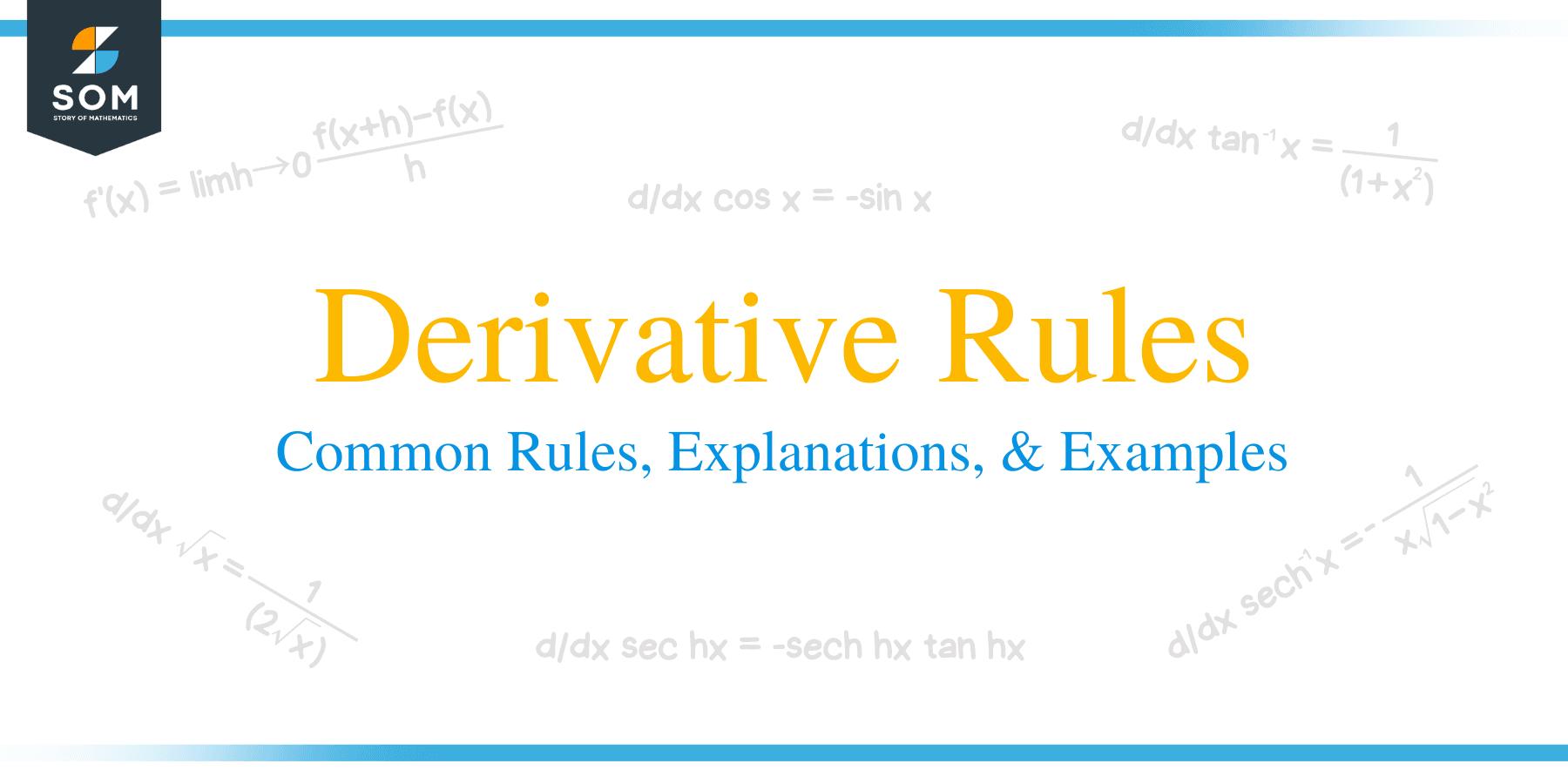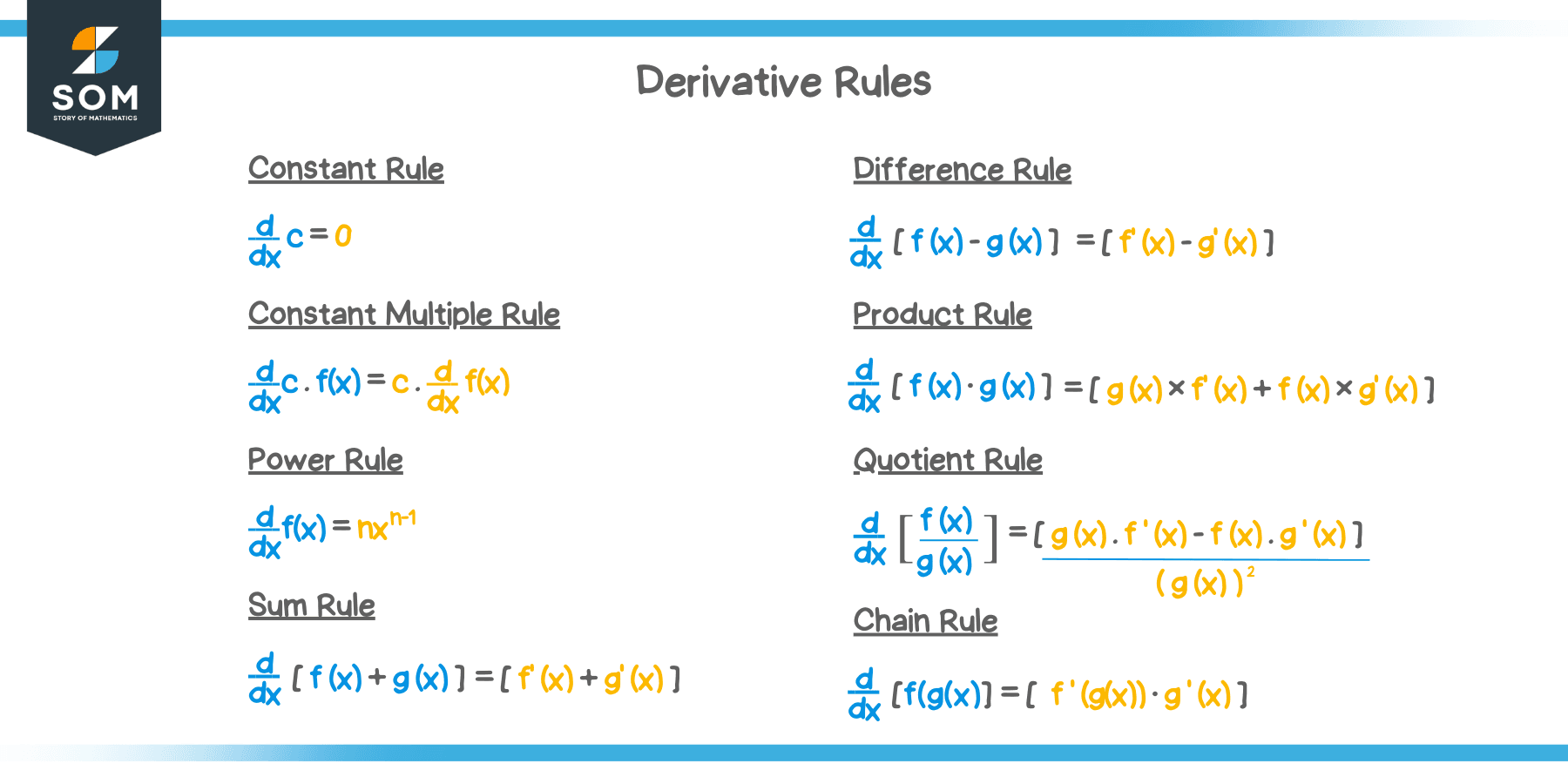- Home
- >
- Derivative rules – Common Rules, Explanations, and Examples
JUMP TO TOPIC
- What are the common rules of derivatives?
- – Constant Rule: $\color{green}\boldsymbol{\dfrac{d}{dx} c = 0}$
- – Constant Multiple Rule: $\color{green}\boldsymbol{\dfrac{d}{dx} c\cdot f(x)= c \cdot \dfrac{d}{dx} f(x)}$
- – Power Rule: $\color{green}\boldsymbol{\dfrac{d}{dx} x^n = nx^{n -1}}$
- – Sum and Difference Rules: $\color{green}\boldsymbol{\dfrac{d}{dx} [f(x) \pm g(x)] = f’(x) \pm g’(x)}$
- – Product Rule: $\color{green}\boldsymbol{\dfrac{d}{dx} [f(x) \cdot g(x)] = f’(x)g(x) +g’(x)f(x)}$
- – Quotient Rule: $\color{green}\boldsymbol{\dfrac{d}{dx} \dfrac{f(x)}{g(x)}= \dfrac{g(x)f’(x) – f(x)g’(x)}{[g(x)]^2}}$
- How to differentiate functions using the list of derivative rules?
Derivative rules – Common Rules, Explanations, and Examples
 Having a list of derivative rules, you can always go back to will make your learning of differential calculus topics much easier. These derivative rules are the most fundamental rules you’ll encounter, and knowing how to apply them to differentiate different functions is crucial in calculus and its fields of applications.
Having a list of derivative rules, you can always go back to will make your learning of differential calculus topics much easier. These derivative rules are the most fundamental rules you’ll encounter, and knowing how to apply them to differentiate different functions is crucial in calculus and its fields of applications.
Mastering the fundamental derivative rules will help you in differentiating complex functions and deriving more complex derivative rules.
This article will review all the fundamental derivative rules we’ve learned in the past and see how we can combine different rules to find the derivative of functions with multiple terms. This will also serve as a refresher and make sure you understand the basic derivative rules before learning more complex derivative rules.
What are the common rules of derivatives?
In the past, we’ve derived the rules from the fundamental definition of derivatives, as shown below.
\begin{aligned}f’(x) = \lim_{h\rightarrow 0}\dfrac{f(x+h) – f(x)}{h} \end{aligned}
As we have also observed, this process can get tedious, especially when you’re working with functions with multiple terms, complex forms, and have composite functions. When dealing with these types of functions’ derivatives, it helps if we already know the common rules of derivatives by heart.
We’ll review each fundamental rule here and briefly discuss how we can apply the particular derivative rule.
– Constant Rule: $\color{green}\boldsymbol{\dfrac{d}{dx} c = 0}$
The constant rule states that the derivative of a constant is equal to $0$. This means that when you’re given a polynomial function, the constants’ derivatives will be equal to $0$ using this rule.
- $\dfrac{d}{dx} 100 =0$
- $\dfrac{d}{dx} -1 =0$
- $\dfrac{d}{dx} \pi =0$
– Constant Multiple Rule: $\color{green}\boldsymbol{\dfrac{d}{dx} c\cdot f(x)= c \cdot \dfrac{d}{dx} f(x)}$
When we have a coefficient before an expression, we can simply factor out the coefficient and take the derivative of the remaining expression.
- $\dfrac{d}{dx} 3x = 3\dfrac{d}{dx} x$
- $\dfrac{d}{dx} 4x^2 = 4\dfrac{d}{dx} x^2$
- $\dfrac{d}{dx} -12e^x = -12\dfrac{d}{dx} e^x$
– Power Rule: $\color{green}\boldsymbol{\dfrac{d}{dx} x^n = nx^{n -1}}$
According to the power rule, differentiating a powered expression, $x^n$, we can simply use $n$ as the derivative’s coefficient and decrease the exponent of $x$ by $1$.
- $\dfrac{d}{dx} x^5 = 5x^4$
- $\dfrac{d}{dx} x^{14} = 14x^{13}$
- $\dfrac{d}{dx} x^{-4} = -4x^{-5}$
– Sum and Difference Rules: $\color{green}\boldsymbol{\dfrac{d}{dx} [f(x) \pm g(x)] = f’(x) \pm g’(x)}$
When a function is made up of two or more simpler functions, we can find its derivative by adding or subtracting the derivatives of the simpler functions. Learn more about sum and difference rules by clicking on the links.
- $\dfrac{d}{dx} (x^5 – 2x) = \dfrac{d}{dx} x^5-\dfrac{d}{dx} 2x$
- $\dfrac{d}{dx} (x^3 + 4x + 6) = \dfrac{d}{dx} x^3 +\dfrac{d}{dx} 4x+\dfrac{d}{dx} 6$
- $\dfrac{d}{dx} \left(x^2 + \sqrt{x} – \dfrac{1}{x}\right) = \dfrac{d}{dx} x^2-\dfrac{d}{dx} \sqrt{x}-\dfrac{d}{dx} \dfrac{1}{x}$
– Product Rule: $\color{green}\boldsymbol{\dfrac{d}{dx} [f(x) \cdot g(x)] = f’(x)g(x) +g’(x)f(x)}$
The product rule states that when a function is a product of two functions, we can find the derivative of functions by pairing the derivative of the first function and the second function. Do the same for the second function’s derivative and first function.
- $\dfrac{d}{dx} (4x)(e^x) = \dfrac{d}{dx} (4x) \cdot e^x -\dfrac{d}{dx} (e^x) \cdot 4x$
- $\dfrac{d}{dx} (-2x)(\sqrt{x}) = \dfrac{d}{dx} (-2x) \cdot \sqrt{x} -\dfrac{d}{dx} \sqrt{x} \cdot -2x$
- $\dfrac{d}{dx} 4xe^x = \dfrac{d}{dx} (4x) \cdot e^x -\dfrac{d}{dx} (e^x) \cdot 4x$
– Quotient Rule: $\color{green}\boldsymbol{\dfrac{d}{dx} \dfrac{f(x)}{g(x)}= \dfrac{g(x)f’(x) – f(x)g’(x)}{[g(x)]^2}}$
From the quotient rule, we can find the derivative of the two functions’ ratio by taking the difference between the product of the derivative of the numerator and the denominator minus the product of the derivative of the denominator and the numerator. Divide this result by the square of the denominator.
- $\dfrac{d}{dx} \dfrac{3x^2}{\sin x} = \dfrac{(\sin x)\dfrac{d}{dx} (3x^2) – (3x^2) \dfrac{d}{dx}\sin x}{(\sin x)^2}$
- $\dfrac{d}{dx} \dfrac{\sqrt{x}}{2x – 1} = \dfrac{(2x -1)\dfrac{d}{dx} \sqrt{x} – \sqrt{x} \dfrac{d}{dx} (2x-1) }{(2x-1)^2}$
- $\dfrac{d}{dx} \dfrac{3x^2-1 }{e^x} = \dfrac{e^x\dfrac{d}{dx} (3x^2-1) – (3x^1 -1) \dfrac{d}{dx} e^x }{(e^x)^2}$
These are the fundamental derivative rules that we should learn by heart if we want to master differentiating the common functions we’ve been dealing with in the past.
How to differentiate functions using the list of derivative rules?
Now that we’ve reviewed the fundamental derivative rules we need, the next important thing for us to learn is knowing how to use a combination of these rules to differentiate polynomial, rational, radical, and other fundamental functions.
- See if the sum or difference rule applies to the function and apply them first.
- When you find constants in the expressions, expect it’s the constants’ derivatives to become zero.
- If the expressions have coefficients before the terms, make sure to apply the constant multiple rule.
- Check if the function is in factored form or a rational expression and apply the product or quotient rule, respectively.
There are instances when we might need to apply more complex derivatives, such as the formula for differentiating composite functions (also known as the chain rule) and trigonometric expressions, as shown below.
Additional Derivative Rules | |
\begin{aligned}\dfrac{d}{dx} f(g(x))= f’(g(x)) g’(x)\end{aligned} | \begin{aligned}\dfrac{d}{dx} a^x = a^x \ln a \end{aligned} |
\begin{aligned}\dfrac{d}{dx} e^x = e^x \end{aligned} | \begin{aligned}\dfrac{d}{dx} \sin x = \cos x\end{aligned} |
\begin{aligned}\dfrac{d}{dx} \cos x = -\sin x\end{aligned} | \begin{aligned}\dfrac{d}{dx} \tan x = \sec^2 x\end{aligned} |
Now that we’ve learned the important derivative rules and the process of differentiating complex expressions, it’s time for us to apply what we’ve learned by working on the functions shown below.
Example 1
Find the derivative of the polynomial function, $f(x) = 4x^3 – 5x^2 + 6x – 1$.
Solution
Since we can see a polynomial function with terms being added and subtracted to each other, we can apply the sum and difference rules to find the derivative of $f(x)$. This means that we take the derivative of each of the terms to find $f’(x)$.
\begin{aligned} f’(x) &= \dfrac{d}{dx}[4x^3-5x^2+6x-1]\\&= \dfrac{d}{dx}4x^3-\dfrac{d}{dx}5x^2+\dfrac{d}{dx}6x-\dfrac{d}{dx}1\end{aligned}
We can then replace $\dfrac{d}{dx}1$ with $0$ and apply the given constant multiple rule to take out the coefficients from each term.
\begin{aligned} f'(x) &= \dfrac{d}{dx}4x^3-\dfrac{d}{dx}5x^2+\dfrac{d}{dx}6x-0\\&= 4\dfrac{d}{dx}x^3-5\dfrac{d}{dx}x^2+6\dfrac{d}{dx}x\end{aligned}
We can use the power rule for each term to differentiate powers $x$ – $x^3$, $x^2$, and $x=x^1$.
\begin{aligned} f'(x)&= 4(3x^{3 -1})-5(2x^{2-1})+6(1x^{1-1})\\&=12x^2 – 10x^1 + 6x^0\\&= 12x^2 -10x + 6\end{aligned}
This shows that through different derivative rules, we can easily find the derivative of polynomials such as $f(x) = 4x^3–5x^2+6x–1$. In fact, we have $f’(x) = 12x^2 -10x + 6$.
Example 2
Find the derivative of the function, $g(x)= \dfrac{\sin x}{4} – 5x^5 + \sqrt{x}$.
Solution
We’ll now work with a more complex function, that consists of three terms: $\dfrac{\sin{x}}{4}$, $5x^4$, and $\sqrt{x}$. Through sum and difference rules, we’ll be able to find the expression for $g’(x)$ by finding the corresponding derivatives of the three terms.
\begin{aligned}g'(x)&= \dfrac{d}{dx} \left[ \dfrac{\sin x}{4} -5x^5 + \sqrt{x}\right ]\\&= \dfrac{d}{dx}\dfrac{\sin x}{4} -\dfrac{d}{dx}5x^5 + \dfrac{d}{dx}\sqrt{x}\end{aligned}
Each term will require different sets of derivative rules for us to find their derivatives, so here’s a table summarizing how we can differentiate each term.
\begin{aligned}boldsymbol{\dfrac{d}{dx} \dfrac{\sin x}{4}}\end{aligned} | \begin{aligned}\dfrac{d}{dx} \dfrac{\sin x}{4} &= \dfrac{1}{4}\dfrac{d}{dx}\sin x,\phantom{x}\color{green}\text{Constant Multiple Rule}\\&=\dfrac{1}{4}\cos x,\phantom{x}\color{green}\text{Derivative of Sine} \end{aligned} |
\begin{aligned}boldsymbol{\dfrac{d}{dx} 5x^5}\end{aligned} | \begin{aligned}\dfrac{d}{dx} 5x^5 &= 5\dfrac{d}{dx}x^5,\phantom{x}\color{green}\text{Constant Multiple Rule}\\&=5(5x^{5 -1}),\phantom{x}\color{green}\text{Power Rule}\\&=25x^4 \end{aligned} |
\begin{aligned}boldsymbol{\dfrac{d}{dx} \sqrt{x}}\end{aligned} | \begin{aligned}\dfrac{d}{dx} \sqrt{x} &= \dfrac{d}{dx} x^{\frac{1}{2}}\\&=\dfrac{1}{2}(x^{\frac{1}{2} -1}),\phantom{x}\color{green}\text{Power Rule}\\&=\dfrac{1}{2}x^{-\frac{1}{2}}\\&=\dfrac{1}{2\sqrt{x}} \end{aligned} |
Let’s substitute these expressions back into $g’(x)$ to find the derivative of $g(x)$.
\begin{aligned}g'(x)&= \dfrac{d}{dx}\dfrac{\sin x}{4} -\dfrac{d}{dx}5x^5 + \dfrac{d}{dx}\sqrt{x}\\&=\dfrac{1}{4}\cos x – 25x^4+ \dfrac{1}{2\sqrt{x}}\end{aligned}
This example shows how we can combine the different derivative rules to find the derivative of a more complex function such as $g(x)$. Hence, we have $g’(x) = \dfrac{1}{4}\cos x – 25x^4+ \dfrac{1}{2\sqrt{x}}$.
Practice Questions
1. Find the derivative of the following polynomial functions:
a. $f(x) = 12x^5–4x^6+2x^4–6$
b. $g(x) = -6x^5–12x^3 –8$
c. $h(x) = -5x^8+6x^6 -12x^2+9x$
2. Find the derivative of the following functions:
a. $f(x) = \dfrac{2}{5x} – 6x^2$
b. $g(x) =4x^2 – 4\sqrt{x} +\dfrac{1}{x}$
c. $h(x) = 2\sqrt{x} -5\sqrt[3]{x}+ \dfrac{1}{x}$
3. Find the derivative of the following functions:
a. $f(x) = (x- 1)(2x + 3)^2$
b. $g(x) = \dfrac{x^2-4x+4}{3x}$
c. $h(x) = \dfrac{6x^2}{\sqrt{4 – 3x}}$
Answer Key
1.
a. $f’(x)=60x^4-24x^5+8x^3$
b. $g’(x)=-30x^4-36x^2$
c. $h’(x)=-40x^7 +36x^5-24x+9$
2.
a. $f’(x) =-\dfrac{2}{5x^2} -12x$
b.$g’(x) = 8x- \dfrac{2}{\sqrt{x}}-\dfrac{1}{x^2}$
c.$h’(x) = \dfrac{1}{\sqrt{x}} – \dfrac{5}{3x^{\frac{2}{3}}} -\dfrac{1}{x^2}$
3.
a.$f’(x) = (6x-1)(2x + 3)$ or $f’(x)= 12x^2 +6x -3$
b.$g’(x) = \dfrac{1}{3} – \dfrac{4}{3x^2}$ or $g’(x) =-\dfrac{4-x^2}{3x^2}$
c.$h’(x)= \dfrac{48x – 27x^2}{(4 -3x)^{\frac{3}{2}}}$
